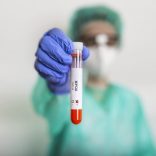Adolescent girls and young women account for 30% of new HIV infections in Mozambique - UN
U.S. government funds construction of new secondary school in Pemba

Ambassador Vrooman and USAID Mission Director Helen Pataki, together with Mozambique Government representatives, lay down the first bricks for the Maringanha School Project. (From left to right: USAID Mozambique Mission Director, Helen Pataki; U.S. Ambassador for Mozambique Peter H. Vrooman; Minister of Education and Human Development, Carmelita Namashulua; Mayor of Pemba, Florete Mutoroua; Secretary of State for Cabo Delgado, António Njanje Taimo Supeia). [Photo courtesy: US Embassy in Mozambique]
The U.S. Government launched the construction of a modern high school, which will provide educational access to 4,500 students in Maringanha, district of Pemba, Cabo Delgado Province. In addition, a memorandum of understanding (MOU) was signed with the Government of Mozambique to demonstrate the commitment of both governments to address the educational needs of this community.
This pivotal event, in harmony with the chorus of Mozambique’s national anthem, echoes the spirit of solidarity, unity and progress:
“…
Mozambique, our Glorious Land
Rock by rock constructing a new day
Millions of arms, one strength
O Beloved country, we will be successful
…”
This powerful anthem encapsulates the determination and resilience that drives the project forward. The laying of the first brick represents the first rock set in place, each brick a symbol of progress and hope. With arms united, the construction of this new high school is destined for success.
The school construction project is part of ongoing efforts from the U.S. Government to support peace-building and foster resilience in northern Mozambique. Mozambique chose Maringanha as the location for the secondary school in light of its significant influx of internally displaced people from elsewhere in Cabo Delgado.
After laying the first brick at the groundbreaking ceremony, Ambassador Peter H. Vrooman said, “We are committing today to build a modern school that will meet the needs of all children of this community. Today’s signing marks a significant milestone in our joint efforts to promote education for youth and resilience in northern Mozambique.”
Under the MOU, the United States Agency for International Development (USAID) will design and construct the secondary school, with an estimated completion date of the first phase at the end of 2024. At that point, the Ministry of Education and Human Development (MINEDH) will begin teaching students in the new facility. The second phase will require an additional 12 months and, once completed, the Maringanha Secondary School will be able to accommodate up to 4,500 students.
Education is a vital area of cooperation between the United States and Mozambique, supported with a variety of ongoing projects, such as bilingual education in primary schools and initiatives to promote girls’ education, which demonstrate tour solidarity with the goal of improving access to quality education for all Mozambican children.
Support for education and conflict-prevention are critical components of the broader U.S. Government assistance strategy in Mozambique. In close collaboration with the Government of the Republic of Mozambique, the U.S. Government provides more than $812 million in annual assistance to improve healthcare, education, and economic prosperity.

- Ambassador Peter H. Vrooman’s remarks
Your Excellency Minister of Education,
Your Excellency Secretary of State of Cabo Delgado Province,
Representatives of Ministry and District Offices,
Ladies and Gentlemen, all protocols observed,
It is an honor to be here today to enhance the strong partnership between the Government of the United States of America and the Government of Mozambique, through the Ministry of Education and Human Development. At this site in particular, this partnership will provide access to education for up to 4,500 students annually, improving and strengthening the education sector in Cabo Delgado Province. We are proud to be here today to see the beginning of construction of the Maringanha Secondary School and to sign the Memorandum of Understanding with the Ministry.
The ongoing conflict in the region has resulted in the flight of nearly 18,000 internally displaced students to the city of Pemba, causing further pressure on the already stressed educational infrastructure. Today we are here with the Ministry of Education to bring solutions to this challenge.
Young people without access to education or job opportunities have been one of the most vulnerable targets to enlisting violent extremist groups. I am therefore happy to join our Mozambican and US teams in the effort to build the Maringanha Secondary School. The construction of the school will include local laborers for up to 40% of the workforce. We envision that these workers and these students will be less vulnerable to these extremist groups and better able to move forward into building a bright future for Cabo Delgado.
The U.S. Government has so far committed $6.6 million to this project through the new 10-year strategy to prevent conflict and promote stability in Mozambique. This strategy supports the Government of Mozambique’s efforts in the reconstruction of critical infrastructure, as prioritized in the Government’s Cabo Delgado Reconstruction Plan.
Although we are just beginning the implementation of this project, we know that the people of Cabo Delgado no longer want to hear speeches. They want physical evidence of our work to improve their current situation. So my appeal is for all of us to celebrate now, but then to quickly roll up our sleeves and start working on full implementation.
The construction of the Maringanha Secondary School in Pemba is a physical demonstration of the commitment of the American people to Mozambique. We are here today as a sign of our successful bilateral partnership in the education sector. This is a day for us to celebrate!
This gift from the American people is an investment in the Mozambican people. We look forward to continuing to work closely with you in the future.
Obrigado e estamos juntos!
The United States Agency for International Development (USAID) leads the U.S. Government’s international development and disaster assistance through partnerships and investments that save lives, reduce poverty, strengthen democratic governance, and help people emerge from humanitarian crises. For more information about USAIDs work, visit www.usaid.gov.












Leave a Reply
Be the First to Comment!
You must be logged in to post a comment.
You must be logged in to post a comment.